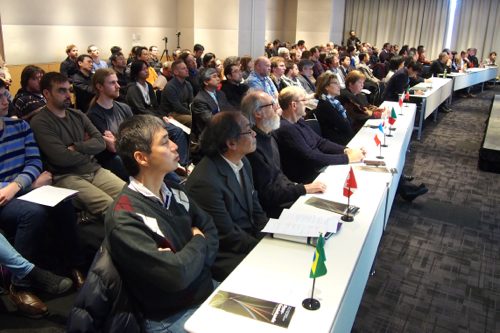
On January 31st, 2015,the Inaugural Symposium of the Hyper-Kamiokande Proto-Collaboration and Signing Ceremony was held at Kashiwa-no-ha Conference Center. The Hyper-Kamiokande project aims to address the mysteries of the origin and evolution of the Universe’s matter and to confront theories of elementary particle unification. To realize these goals the project will combine a high intensity neutrino beam from the Japan Proton Accelerator Research Complex (J-PARC) with a new detector based upon precision neutrino experimental techniques developed in Japan. The Hyper-Kamiokande project will be about 25 times larger than Super-Kamiokande, the research facility that was first to discover evidence for neutrino mass in 1998.
The symposium was held to commemorate and promote the proto-collaboration to advance the Hyper-Kamiokande project internationally. In addition, a signing ceremony marking an agreement for the promotion of the project between the Institute for Cosmic Ray Research (ICRR) of the University of Tokyo and the Institute of Particle and Nuclear Studies of the High Energy Accelerator Research Organization (KEK) took place during the symposium.
The symposium was attended by more than 100 Hyper-Kamiokande researchers including an international steering committee and an institutional board of representatives with members from 13 countries to cerebrate the event.
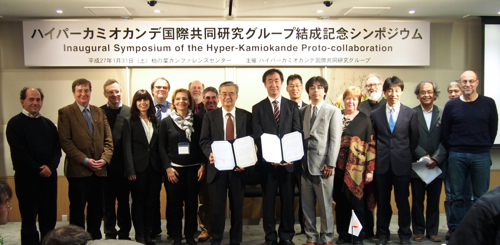
Institute for Cosmic Ray Research (ICRR) of the University of Tokyo and Institute of Particle and Nuclear Studies of High Energy Accelerator Research Organization (KEK) signed the Memorandum of Understanding of the cooperation in the Hyper-Kamiokande project.
For more information about Hyper-Kamiokande, symposium details and presentation slides, please visit the Hyper-Kamiokande newsroom “Inaugural Symposium of the Hyper-Kamiokande Proto-Collaboration”.
High-resolution images of Hyper-Kamiokande are available from here (for press use only).
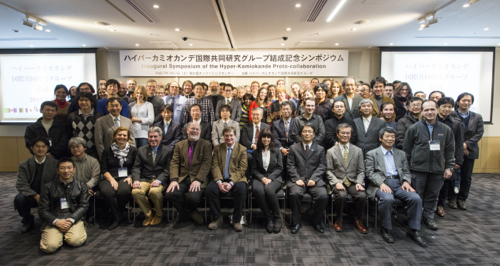
Program
Host: Hyper-Kamiokande International Proto-Collaboration
Co-Hosts: Institute for Cosmic Ray Research, the University of Tokyo / Institute of Particle and Nuclear Studies, High Energy Accelerator Research Organization
Master of Ceremonies : Akira Konaka (TRIUMF/RCNP)
・Overview of the Hyper-Kamiokande Project (10 min) Masato Shiozawa, University of Tokyo)
・The J-PARC Neutrino Beam Facility (10 min) Takashi Kobayashi, KEK
・The International Proto-Collaboration (15 min) Francesca Di Lodovico, Queen Mary University of London
・International Cooperation (15 min) Chris Walter, Duke University
・Memorandum for the Promotion of the Hyper-Kamiokande Project (15 min)
Masanori Yamauchi, KEK
Takaaki Kajita, University of Tokyo
・Closing (10 min) Tsuyoshi Nakaya, Kyoto University
Overview
[Overview of the Hyper-Kamiokande Project]
In partnership with both foreign and domestic universities and research institutions, the University of Tokyo Institute for Cosmic Ray Research (ICRR) has pioneered solar and atmospheric neutrino research with the world’s largest water Cherenkov detector, Super-Kamiokande. Additionally, as joint host with the High Energy Accelerator Research Organization (KEK), and using accelerator neutrinos from Japan Proton Accelerator Research Complex (J-PARC), it has carried out the long baseline neutrino oscillation experiment T2K. Among the results of research at Super-Kamiokande, the discoveries that in comparison to other elementary particles neutrinos have extremely small but finite masses and that three types of neutrinos mix almost maximally in their flight, support the ideas of theories beyond the standard model of particle physics which unify the elementary particles and forces.
The Hyper-Kamiokande project seeks to reveal the full nature of neutrino masses and their mixing using both a high intensity neutrino beam from J-PARC and a new megaton-class water Cherenkov detector to succeed Super-Kamiokande. In particular, the project aspires not only to discover CP violation (particle-antiparticle asymmetry) in neutrinos, but to close in on theories of elementary particle unification with the world’s first discovery of proton decay. Expanding solar, atmospheric, and cosmic neutrino observations, as well as advancing neutrino interaction research and neutrino astronomy at Hyper-Kamiokande will provide new knowledge to particle and nuclear physics, cosmology, and astronomy. As an international project, researchers from around the world are working to start the Hyper-Kamiokande experiment in 2025.
[The Hyper-Kamiokande Detector]
Hyper-Kamiokande (Figure 1) will be a megaton-scale underground water vessel lined with approximately 100,000 extremely high performance photosensors, making it the world’s largest neutrino and proton decay detector. While this detector is a “microscope” for observing elementary particles, it is at the same time a “telescope” that can observe the interior of the sun and supernova using neutrinos. In comparison to the current experiment, Super-Kamiokande, it will have 20 times the ability to detect neutrinos and is expected to discover differences in the properties of neutrinos and antineutrinos, known as CP violation (particle-antiparticle asymmetry). Further, with many more protons to observe it aims to discover rare proton decay phenomena. The world’s most sensitive and precise large-aperture photosensors (Figure 2), with 50% more sensitivity than those used in Super-Kamiokande, will be installed within the inner volume of the water vessel. These sensors are one of the important elements contributing to the realization of this world-leading detector.
[The Hyper-Kamiokande International Proto-Collaboration]
The Hyper-Kamiokande proto-collaboration will include an international steering committee and an institutional board of representatives with members from 13 countries. Through this organizational structure collaborating researchers will work to lay plans for and to secure funding for the prompt realization of the experiment.
Hyper-Kamiokande Member States: Brazil, Canada, France, Italy, Japan, Korea, Poland, Portugal (observer state), Russia, Spain, Switzerland, UK, USA.
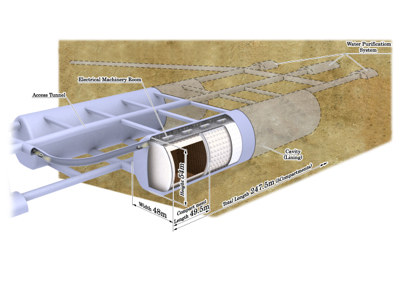
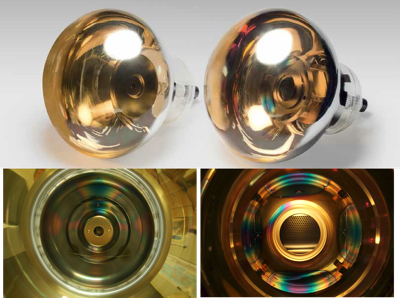
Media Contacts
・Concerning Hyper-Kamiokande
Professor Masato Shiozawa
The University of Tokyo Institute for Cosmic Ray Research
・Concerning symposium coverage
Misato Hayashida, Public Relations Specialist
The University of Tokyo Institute for Cosmic Ray Research
TEL: 04-7136-5148
E-mail: misato@icrr.u-tokyo.ac.jp (please change ◎ to @)
Links
・6th Open Meeting for the Hyper-Kamiokande Project
・the Hyper-Kamiokande newsroom “Inaugural Symposium of the Hyper-Kamiokande Proto-Collaboration”
・HK Homepage





